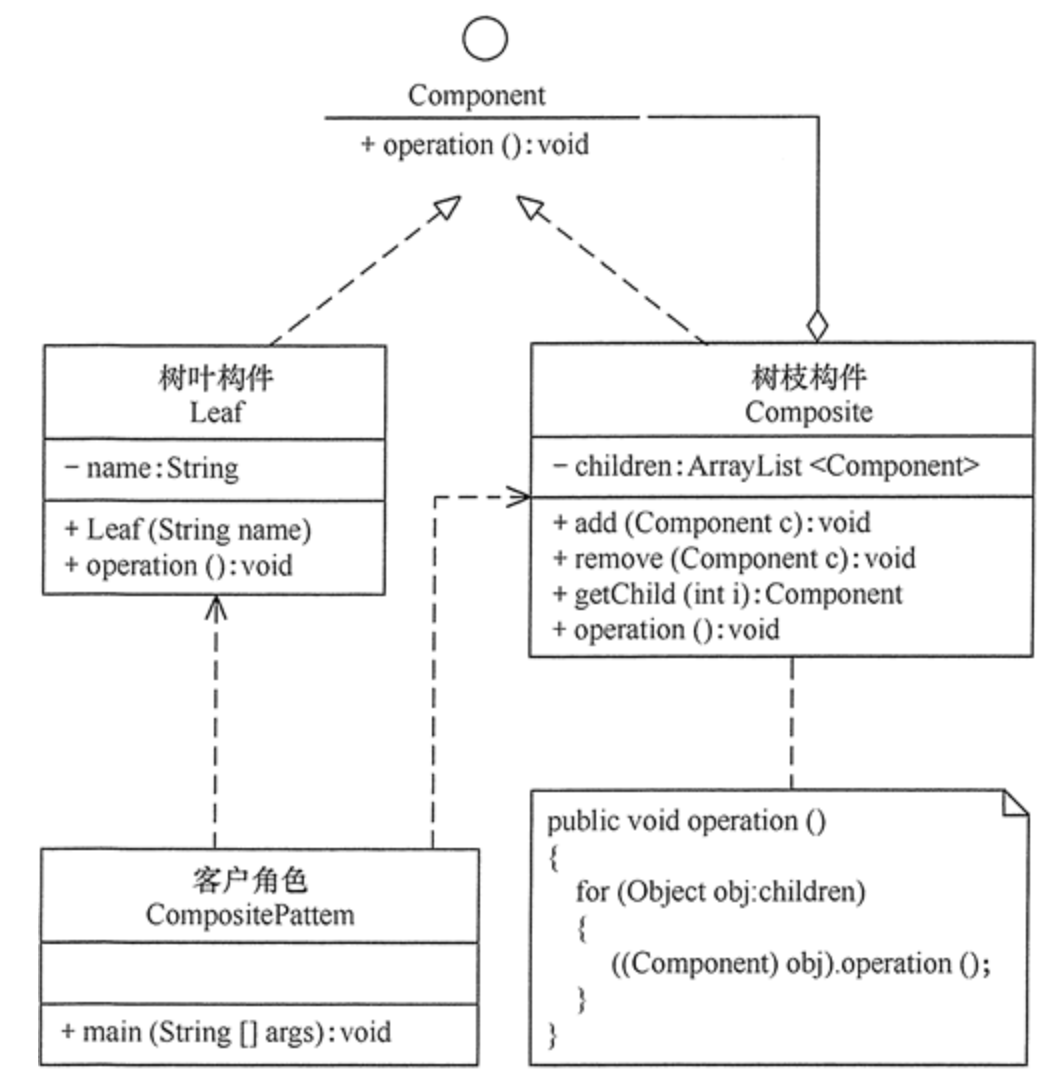一、组合模式的定义
组合(Composite)模式的定义:有时又叫作部分-整体模式,它是一种将对象组合成树状的层次结构的模式,用来表示“部分-整体”的关系,使用户对单个对象和组合对象具有一致的访问性。这种类型的设计模式属于结构型模式,它创建了对象组的树形结构。
聚合与组合都是表示整体和个体的关联关系,他们之间最大的区别在于子类被父类控制的程度。组合的父子类关系比聚合要强:
-
聚合:has-a关系,父类包含子类,子类可以独立于父类存在
Class ==> Student:班级和学生是一种聚合关系。一个班级,可以有学生,也可以没学生;反过来,当把班级解散,学生仍然存在;同时学生可以归属于多个班级(兴趣班、课外班)。
-
组合:part-of关系,父类拥有子类,子类不能独立于父类存在
Body ⇒ Cell:身体与细胞是一个组合关系。但我们创建一个身体,细胞随之被创建;反过来,当我们销毁一个身体,细胞随之被销毁。
二、组合模式优缺点
组合模式的主要优点有:
- 组合模式使得客户端代码可以一致地处理单个对象和组合对象,无须关心自己处理的是单个对象,还是组合对象,这简化了客户端代码;
- 更容易在组合体内加入新的对象,客户端不会因为加入了新的对象而更改源代码,满足“开闭原则”;
其主要缺点是:
- 设计较复杂,客户端需要花更多时间理清类之间的层次关系;
- 不容易限制容器中的构件;
- 不容易用继承的方法来增加构件的新功能;
三、组合模式的实现
组合模式的结构不是很复杂,下面对它的结构和实现进行分析。
组合模式包含以下主要角色。
- 抽象构件(Component)角色:它的主要作用是为树叶构件和树枝构件声明公共接口,并实现它们的默认行为。在透明式的组合模式中抽象构件还声明访问和管理子类的接口;在安全式的组合模式中不声明访问和管理子类的接口,管理工作由树枝构件完成。
- 树叶构件(Leaf)角色:是组合中的叶节点对象,它没有子节点,用于实现抽象构件角色中 声明的公共接口。
- 树枝构件(Composite)角色:是组合中的分支节点对象,它有子节点。它实现了抽象构件角色中声明的接口,它的主要作用是存储和管理子部件,通常包含 Add()、Remove()、GetChild() 等方法。
组合模式分为透明式的组合模式和安全式的组合模式。
透明方式:在该方式中,由于抽象构件声明了所有子类中的全部方法,所以客户端无须区别树叶对象和树枝对象,对客户端来说是透明的。但其缺点是:树叶构件本来没有 Add()、Remove() 及 GetChild() 方法,却要实现它们(空实现或抛异常),这样会带来一些安全性问题。其结构图如图所示:

假如要访问集合 c0={leaf1,{leaf2,leaf3}} 中的元素,其对应的树状图如图所示:

其代码实现如下:
public class CompositePattern { public static void main(String[] args) { Component c0=new Composite(); Component c1=new Composite(); Component leaf1=new Leaf("1"); Component leaf2=new Leaf("2"); Component leaf3=new Leaf("3"); c0.add(leaf1); c0.add(c1); c1.add(leaf2); c1.add(leaf3); c0.operation(); } } //抽象构件 interface Component { void add(Component c); void remove(Component c); Component getChild(int i); void operation(); } //树叶构件 class Leaf implements Component { private String name; public Leaf(String name) { this.name=name; } public void add(Component c){ } public void remove(Component c){ } public Component getChild(int i) { return null; } public void operation() { System.out.println("树叶"+name+":被访问!"); } } //树枝构件 class Composite implements Component { private ArrayList<Component> children=new ArrayList<Component>(); public void add(Component c) { children.add(c); } public void remove(Component c) { children.remove(c); } public Component getChild(int i) { return children.get(i); } public void operation() { for(Object obj:children) { ((Component)obj).operation(); } } }
输出结果如下:
树叶1:被访问!
树叶2:被访问!
树叶3:被访问!
安全方式:在该方式中,将管理子构件的方法移到树枝构件中,抽象构件和树叶构件没有对子对象的管理方法,这样就避免了上一种方式的安全性问题,但由于叶子和分支有不同的接口,客户端在调用时要知道树叶对象和树枝对象的存在,所以失去了透明性。其结构图如图所示:

其代码实现如下:
public class CompositeSafePattern { public static void main(String[] args) { CompositeSafe c0=new CompositeSafe(); CompositeSafe c1=new CompositeSafe(); ComponentSafe leaf1=new LeafSafe("1"); ComponentSafe leaf2=new LeafSafe("2"); ComponentSafe leaf3=new LeafSafe("3"); c0.add(leaf1); c0.add(c1); c1.add(leaf2); c1.add(leaf3); c0.operation(); } } //抽象构件 interface ComponentSafe { void operation(); } //树叶构件 class LeafSafe implements ComponentSafe { private String name; public LeafSafe(String name) { this.name=name; } public void operation() { System.out.println("树叶"+name+":被访问!"); } } //树枝构件 class CompositeSafe implements ComponentSafe { private ArrayList<ComponentSafe> children=new ArrayList<ComponentSafe>(); public void add(ComponentSafe c) { children.add(c); } public void remove(ComponentSafe c) { children.remove(c); } public ComponentSafe getChild(int i) { return children.get(i); } public void operation() { for(Object obj:children) { ((ComponentSafe)obj).operation(); } } }
四、组合模式实际运用
说明:假如李先生到韶关“天街e角”生活用品店购物,用 1 个红色小袋子装了 2 包婺源特产(单价 7.9 元)、1 张婺源地图(单价 9.9 元);用 1 个白色小袋子装了 2 包韶关香藉(单价 68 元)和 3 包韶关红茶(单价 180 元);用 1 个中袋子装了前面的红色小袋子和 1 个景德镇瓷器(单价 380 元);用 1 个大袋子装了前面的中袋子、白色小袋子和 1 双李宁牌运动鞋(单价 198 元)。
最后“大袋子”中的内容有:{1 双李宁牌运动鞋(单价 198 元)、白色小袋子{2 包韶关香菇(单价 68 元)、3 包韶关红茶(单价 180 元)}、中袋子{1 个景德镇瓷器(单价 380 元)、红色小袋子{2 包婺源特产(单价 7.9 元)、1 张婺源地图(单价 9.9 元)}}},现在要求编程显示李先生放在大袋子中的所有商品信息并计算要支付的总价。
代码实现如下(安全方式写法):
/** * 说明:假如李先生到韶关“天街e角”生活用品店购物,用 1 个红色小袋子装了 2 包婺源特产(单价 7.9 元)、1 张婺源地图(单价 9.9 元); * 用 1 个白色小袋子装了 2 包韶关香藉(单价 68 元)和 3 包韶关红茶(单价 180 元);用 1 个中袋子装了前面的红色小袋子和 1 个景德镇瓷器(单价 380 元); * 用 1 个大袋子装了前面的中袋子、白色小袋子和 1 双李宁牌运动鞋(单价 198 元)。 * * 最后“大袋子”中的内容有:{ 1 双李宁牌运动鞋(单价 198 元)、
* 白色小袋子{ 2 包韶关香菇(单价 68 元)、3 包韶关红茶(单价 180 元)}、 * 中袋子{ 1个景德镇瓷器(单价 380 元)、
* 红色小袋子{2 包婺源特产(单价 7.9 元)、1 张婺源地图(单价 9.9 元)}}}, * 现在要求编程显示李先生放在大袋子中的所有商品信息并计算要支付的总价。 */ public class CompositeApplying { public static void main(String[] args) { float s = 0; Bags BigBag, mediumBag, smallRedBag, smallWhiteBag; Goods sp; BigBag = new Bags("大袋子"); mediumBag = new Bags("中袋子"); smallRedBag = new Bags("红色小袋子"); smallWhiteBag = new Bags("白色小袋子"); sp = new Goods("婺源特产", 2, 7.9f); smallRedBag.add(sp); sp = new Goods("婺源地图", 1, 9.9f); smallRedBag.add(sp); sp = new Goods("韶关香菇", 2, 68); smallWhiteBag.add(sp); sp = new Goods("韶关红茶", 3, 180); smallWhiteBag.add(sp); sp = new Goods("景德镇瓷器", 1, 380); mediumBag.add(sp); mediumBag.add(smallRedBag); sp = new Goods("李宁牌运动鞋", 1, 198); BigBag.add(sp); BigBag.add(smallWhiteBag); BigBag.add(mediumBag); System.out.println("您选购的商品有:"); BigBag.show(); s = BigBag.calculation(); System.out.println("要支付的总价是:" + s + "元"); } } //抽象构件:物品 interface Articles { public float calculation(); //计算 public void show(); } //树叶构件:商品 class Goods implements Articles { private String name; //名字 private int quantity; //数量 private float unitPrice; //单价 public Goods(String name, int quantity, float unitPrice) { this.name = name; this.quantity = quantity; this.unitPrice = unitPrice; } public float calculation() { return quantity * unitPrice; } public void show() { System.out.println(name + "(数量:" + quantity + ",单价:" + unitPrice + "元)"); } } //树枝构件:袋子 class Bags implements Articles { private String name; //名字 private ArrayList<Articles> bags = new ArrayList<Articles>(); public Bags(String name) { this.name = name; } public void add(Articles c) { bags.add(c); } public void remove(Articles c) { bags.remove(c); } public Articles getChild(int i) { return bags.get(i); } public float calculation() { float s = 0; for (Object obj : bags) { s += ((Articles) obj).calculation(); } return s; } public void show() { for (Object obj : bags) { ((Articles) obj).show(); } } }
测试结果如下:
您选购的商品有: 李宁牌运动鞋(数量:1,单价:198.0元) 韶关香菇(数量:2,单价:68.0元) 韶关红茶(数量:3,单价:180.0元) 景德镇瓷器(数量:1,单价:380.0元) 婺源特产(数量:2,单价:7.9元) 婺源地图(数量:1,单价:9.9元) 要支付的总价是:1279.7元
五、组合模式的应用场景
前面分析了组合模式的结构与特点,下面分析它适用的以下应用场景。
- 在需要表示一个对象整体与部分的层次结构的场合。
- 要求对用户隐藏组合对象与单个对象的不同,用户可以用统一的接口使用组合结构中的所有对象的场合。
六、组合模式的扩展
如果对前面介绍的组合模式中的树叶节点和树枝节点进行抽象,也就是说树叶节点和树枝节点还有子节点,这时组合模式就扩展成复杂的组合模式了,如 Java AWT/Swing 中的简单组件 JTextComponent 有子类 JTextField、JTextArea,容器组件 Container 也有子类 Window、Panel。复杂的组合模式的结构图如图所示:






【推荐】国内首个AI IDE,深度理解中文开发场景,立即下载体验Trae
【推荐】编程新体验,更懂你的AI,立即体验豆包MarsCode编程助手
【推荐】抖音旗下AI助手豆包,你的智能百科全书,全免费不限次数
【推荐】轻量又高性能的 SSH 工具 IShell:AI 加持,快人一步
· .NET Core 中如何实现缓存的预热?
· 从 HTTP 原因短语缺失研究 HTTP/2 和 HTTP/3 的设计差异
· AI与.NET技术实操系列:向量存储与相似性搜索在 .NET 中的实现
· 基于Microsoft.Extensions.AI核心库实现RAG应用
· Linux系列:如何用heaptrack跟踪.NET程序的非托管内存泄露
· TypeScript + Deepseek 打造卜卦网站:技术与玄学的结合
· 阿里巴巴 QwQ-32B真的超越了 DeepSeek R-1吗?
· 【译】Visual Studio 中新的强大生产力特性
· 10年+ .NET Coder 心语 ── 封装的思维:从隐藏、稳定开始理解其本质意义
· 【设计模式】告别冗长if-else语句:使用策略模式优化代码结构